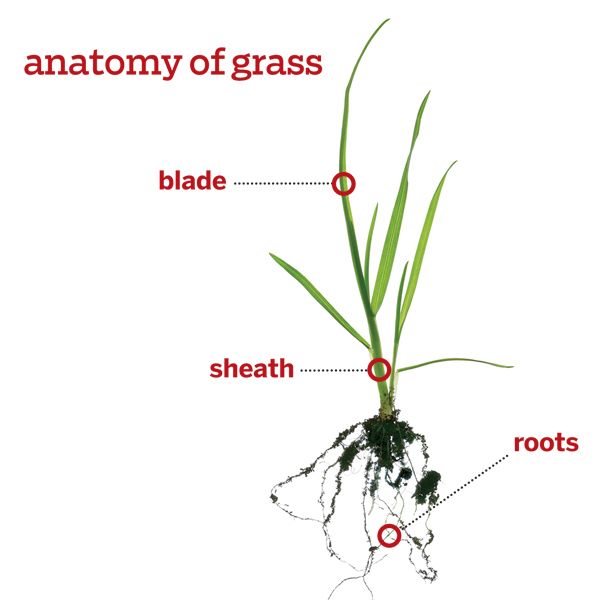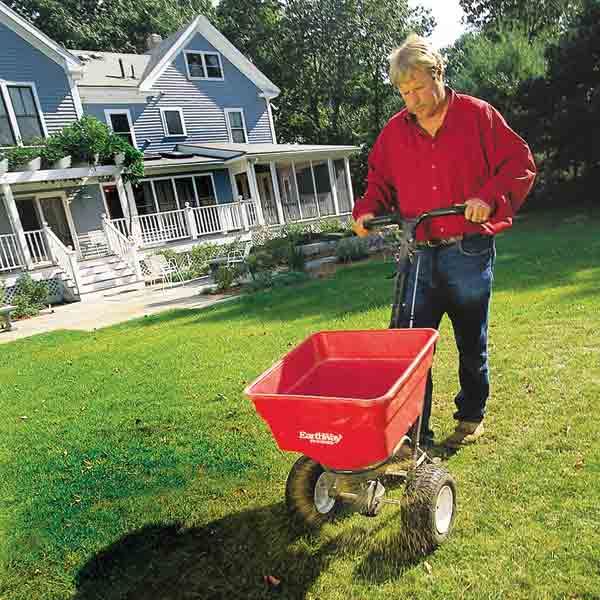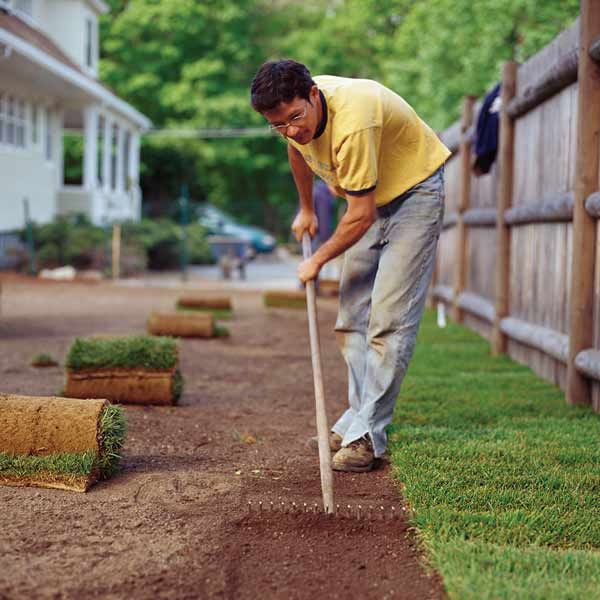A lush, green lawn is more than just a beautiful addition to your home — it’s a living carpet that provides countless benefits. From increasing property value to creating a relaxing outdoor space, a well-maintained lawn is a source of pride for many homeowners.
This comprehensive guide will walk you through everything you need to know about creating and maintaining the perfect lawn, from understanding grass basics to seasonal care and eco-friendly practices.
To ensure you’re getting all of the best advice on how to maintain your lawn, we’ve tapped authorities such as This Old House landscape contractor Roger Cook; Dr. Bruce Augustin, chief agronomist at Scotts; Kevin Morris at the National Turfgrass Federation; and organic lawn advocate Paul Tukey. From them, you’ll learn the fundamentals: how to plant grass, when to mow it, how much to water it, and what you need to do at each stage of the growing season.
Anatomy of Grass
Each 1,000 square feet of healthy lawn contains about a million plants. Each plant has three main parts.
- Blade: Makes food from sunlight. Cut off no more than one-third at a time.
- Sheath: Protects and supports the base of the blade.
- Roots: Gathers nutrients and water from the soil. Help them grow deeper by leaving the blades at least 3 inches long.

Choosing the Right Grass for Your Climate
Selecting the appropriate grass seed type for your region is fundamental to establishing a thriving lawn. Climate plays a significant role in determining which grasses will flourish in your yard. Grasses are generally categorized into two main types: cool-season and warm-season grasses.
Cool-Season Grasses
Cool-season grasses thrive in regions with cold winters and mild summers. They grow most actively during spring and fall when temperatures are between 60°F and 75°F, and are best suited for the northern U.S. and Canada. Popular cool-season grasses include:
- Kentucky Bluegrass: Known for its fine texture and deep blue-green color.
- Fescue: Comes in several varieties and is known for its drought tolerance.
- Perennial Ryegrass: Germinates quickly and is often used in seed mixes for quick establishment.
Warm-Season Grasses
Warm-season grasses are adapted to hot climates and grow most actively when temperatures are between 80°F and 95°F. They typically go dormant and turn brown during cooler months. These grasses are ideal for the southern U.S. and other warm regions. Common warm-season grasses include:
- Bermuda Grass: Highly drought-tolerant and wear-resistant.
- Zoysia: Forms a dense, carpet-like lawn and has good shade tolerance.
- St. Augustine: Thrives in tropical and subtropical regions and has good shade tolerance.

Methods To Start a New Lawn
When establishing a new lawn, you have several options to choose from. Your choice will depend on factors such as budget, time constraints, and the specific grass type you’ve selected.
Seeding Your Lawn
Seeding is the most economical way to start a new lawn, costing about $440 to $1,750, according to Angi. Here’s how to seed effectively:
- Prepare the soil by loosening the top couple of inches with an iron rake.
- Work in a starter fertilizer or slow-release organic fertilizer.
- Spread the seed evenly, using about one pound per 200 square feet.
- Cover with a thin layer of soil or compost.
- Use a drum roller partially filled with water to ensure good seed-soil contact.
- Apply a thin layer of straw mulch to retain moisture.
Keep the soil consistently moist until the seeds germinate, which typically takes about three weeks. Once the grass is established, gradually reduce watering frequency.
Pro advice: “When I seed a lawn, I usually spread it at a slightly heavier dose, about one-third more than the bag suggests, to ensure I get a good stand of new grass,” says Roger Cook, This Old House landscape contractor.
Hydroseeding
Hydroseeding involves spraying a mixture of seeds, water, mulch, and fertilizer onto prepared soil. This method costs about $500 to $1,910 when done professionally, according to Angi.
It’s faster and provides a more even application than traditional seeding. The mulch helps retain moisture and prevent erosion, and the method results in a higher germination rate due to consistent seed-soil contact
However, hydroseeding is significantly more expensive than traditional seeding and usually requires professional application. You may need to book the job well in advance during peak seasons.
Hydroseeding is particularly effective for large areas or slopes where erosion control is a concern.
Laying Sod
Sod provides an instant lawn but comes at a higher cost, typically $1,070 and $3,000 for a full lawn, according to Angi. Here’s how you can lay sod yourself:
- Prepare the soil by rototilling to a depth of six inches and raking smooth.
- Water the soil before laying sod.
- Lay sod in a staggered pattern, ensuring tight seams between pieces.
- Use a roller to ensure good root-soil contact.
- Water thoroughly and keep moist for several weeks until roots are established.
Sod can be installed at any time during the growing season and is ideal for areas prone to erosion or where quick results are desired.
Using Plugs for Warm-Climate Grasses
Plugs are small chunks of grass with soil and roots attached. They are often used for warm-season grasses like Zoysia or Bermuda. Plugs cost around $50 for 50 square feet of coverage, according to our research with big-box hardware stores and specialty retailers.
To plant plugs:
1. Prepare the soil as you would for seeding.
2. Plant plugs six to 12 inches apart.
3. Water thoroughly and keep moist until established.
Plugs take longer to fill in completely but are less expensive than sod and allow for better customization to your lawn’s layout.

Is Your Grass Getting the Nutrients it Needs?
When soil lacks the essential elements for growth, grass becomes more vulnerable to disease, weeds, and pests. Your state’s cooperative extension service can provide a soil test for about $20 that will tell you the makeup of your soil and the concentration of different nutrients.
Some of these services will also explain how to correct deficiencies. The test should be repeated every three years to keep up with any changes to the soil. Here are the most important categories most soil tests cover.
- pH: Determines whether roots can absorb minerals in soil. Add lime to raise soil pH; add sulfur to lower it.
- Nitrogen (N): Encourages blade growth. Most turf requires 3 to 4 pounds of nitrogen per 1,000 square feet each year but no more than 1 pound at a time.
- Phosphorus (P): Helps grass develop strong roots. If low, add bone meal, dried seaweed, or fish emulsion.
- Potassium (K): Promotes growth and improves resistance to disease and drought. If low, add granite dust or dried seaweed.
- Calcium (Ca): Builds strong cell walls and suppresses the growth of many weeds. If low, add agricultural lime (not masonry lime) and wood ash, which also raises soil pH.
- Magnesium (Mg): Aids in chlorophyll production. If low, add dolomitic lime.

Proper Watering Techniques for a Lush Lawn
Water is essential for a healthy lawn, but knowing how much and when to water can make a significant difference in your grass’s health and appearance. Proper watering techniques not only promote a lush lawn but also conserve water and prevent issues like fungal diseases.
How Much Water Does Your Lawn Need?
The general rule of thumb is to provide about one inch of water per week, either from rainfall or irrigation. However, this can vary based on factors such as:
- Grass type: Some grasses are more drought-tolerant than others.
- Soil type: Sandy soils drain quickly and may require more frequent watering.
- Climate: Hot, dry conditions increase water needs.
- Season: Lawns typically require more water during peak growing seasons.
To measure how much water your lawn is receiving, place a few shallow containers around your yard while watering. When the containers have collected about 1/2 to 1/3 inch of water, you’ve watered enough for that session.
Best Times To Water Your Lawn
The timing of your watering can significantly impact its effectiveness. The best time to water is early morning, before 10 a.m. This allows the grass to dry before evening, reducing the risk of fungal diseases.
You should avoid watering in the heat of the day, as much of the water will evaporate before the grass can absorb it. If you must water in the evening, do so early enough that the grass blades dry before nightfall. Water deeply and less frequently to encourage deep root growth. This makes your lawn more drought-resistant and healthier overall.
Mowing Tips for a Well-Manicured Yard
Proper mowing helps maintain a healthy and attractive lawn. The right mowing practices can promote stronger grass, discourage weed growth, and enhance your lawn’s overall appearance.
Ideal Mowing Height for Different Grass Types
The optimal mowing height varies depending on the type of grass:
- Cool-season grasses (such as Kentucky Bluegrass and Fescue): Keep between 2.5 to 4 inches tall.
- Warm-season grasses (like Bermuda and Zoysia): Maintain between 1 to 2 inches tall.
As a general rule, don’t remove more than one-third of the grass blade length in a single mowing session. Taller grass promotes deeper root growth, which leads to a more drought-resistant and healthier lawn.
Mowing Frequency
Typically, mowing once a week during the growing season is sufficient for most lawns. However, you may need to mow more frequently during periods of rapid growth or less often during dry spells.
Remember to vary your mowing pattern each time to prevent wear patterns and encourage upright growth. Keep your mower blades sharp to ensure clean cuts, which heal quickly and are less susceptible to disease.
Fertilizing Your Lawn for Optimal Growth
Fertilization is a key component of lawn care, providing essential nutrients that may be lacking in your soil. Proper fertilization promotes healthy growth, vibrant color, and increased resistance to pests and diseases.
Types of Lawn Fertilizers
There are several types of fertilizers available, including:
- Synthetic fertilizers: Fast-acting and readily available, these provide immediate nutrients to the lawn.
- Organic fertilizers: Derived from natural sources, these release nutrients slowly and improve soil structure over time.
- Slow-release fertilizers: These provide a steady supply of nutrients over an extended period, reducing the risk of nutrient burn.
- Liquid fertilizers: These are quickly absorbed but may require more frequent application.
When and How To Apply Fertilizer
The timing and method of fertilizer application are crucial for optimal results:
- For cool-season grasses, the best times to fertilize are early spring and fall.
- Warm-season grasses benefit most from fertilization in late spring and summer.
- Apply fertilizer when the grass is dry, but water thoroughly afterward to help nutrients reach the roots.
- Use a spreader for even application, following the product’s recommended application rate. Avoid over-fertilizing, as this can lead to rapid growth that requires more frequent mowing and can make the grass more susceptible to pests and diseases.
Dealing with Common Lawn Problems
Even well-maintained lawns can face challenges from diseases, pests, and weeds. Here’s how to deal with some common issues that may arise in your lawn.
Identifying and Treating Lawn Diseases
Common lawn diseases include:
- Brown patches: Circular brown areas in the lawn, often caused by high humidity and heat.
- Dollar spots: Small, circular patches of brown grass, typically due to drought stress.
- Snow mold: Gray or pink patches that appear after snow melts, common in cool-season grasses.
Treatment often involves adjusting watering practices, improving drainage, and in severe cases, applying fungicides. Maintaining proper mowing height and avoiding overwatering can help prevent many lawn diseases.
Effective Weed Control Strategies
Weeds compete with grass for nutrients, water, and sunlight. Here are some strategies you can use to kill weeds without killing your grass.
- Cultural control: Maintain a dense, healthy lawn that naturally crowds out weeds.
- Manual removal: Pull weeds by hand, ensuring you remove the entire root system.
- Herbicides: Use selectively and according to label instructions. Consider spot-treating rather than blanket application.
- Pre-emergent treatments: Apply in early spring to prevent weed seeds from germinating.
Seasonal Lawn Care Guide
Proper lawn care is a year-round commitment, with each season requiring specific tasks to maintain a healthy, vibrant lawn. Understanding and implementing these seasonal practices will ensure your lawn looks its best throughout the year.
Spring Lawn Care Tasks
Spring is a crucial time for lawn rejuvenation and preparation for the growing season:
- Rake thoroughly to remove dead grass and winter debris.
- Test soil pH and nutrients, amending as necessary.
- Overseed bare or thin areas once soil temperature reaches 50°F.
- Apply pre-emergent herbicide to prevent crabgrass and other annual weeds.
- Begin mowing when grass reaches three inches in height.
For more detailed information on fall lawn care, check out our lawn care musts for your fall yard guide.
Summer Lawn Maintenance
Summer brings challenges of heat and potential drought:
- Water deeply and less frequently to encourage deep root growth.
- Mow at a higher setting to protect grass roots from heat stress.
- Control weeds through proper mowing and spot treatment.
- Monitor for signs of pests or diseases and treat them promptly.
Fall Lawn Preparation
Fall is ideal for strengthening your lawn before winter:
- Continue regular mowing until grass stops growing.
- Aerate and dethatch if necessary to improve soil health.
- Overseed cool-season lawns to thicken turf.
- Apply fall fertilizer to promote root growth.
- Rake leaves promptly to prevent smothering the grass.
Winter Lawn Protection
While grass growth slows in winter, some care is still necessary:
- Avoid walking on frozen grass to prevent damage.
- Remove any remaining leaves or debris.
- Plan for next year’s lawn care strategy.
- Service lawn equipment for the upcoming spring season.
Our Conclusion
A perfect lawn doesn’t happen by chance. It requires careful planning, consistent maintenance, and an understanding of the particular needs of your grass type and climate. By following this comprehensive guide, you can achieve a lush, green lawn that not only enhances your home’s curb appeal but also provides a beautiful outdoor space for relaxation and recreation.

